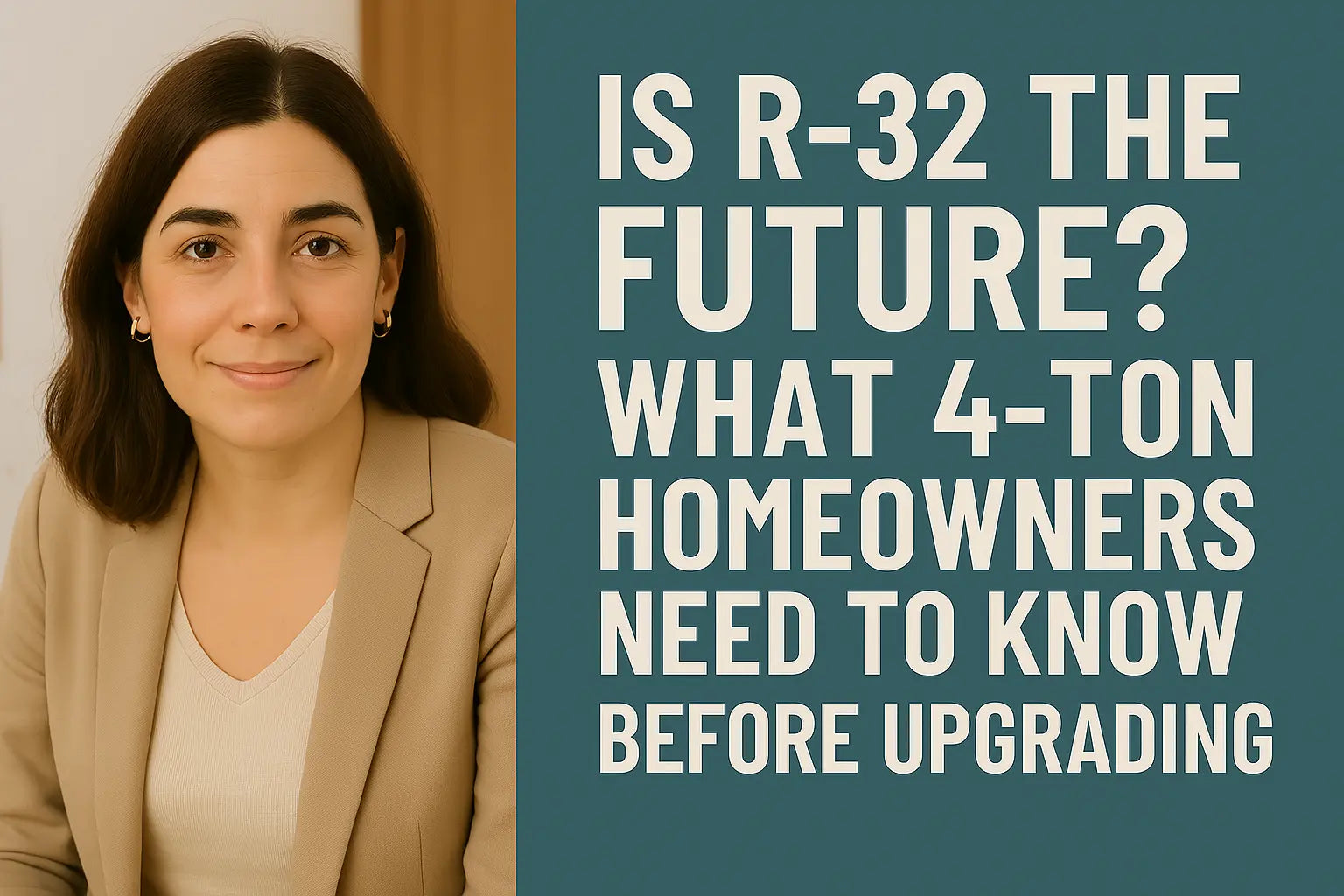Hey Friends, It's Mavi 😎
Okay, full honesty—when I first heard about R-32 refrigerant, I rolled my eyes. “Great, another HVAC acronym,” I thought, probably while holding an iced coffee and dodging an over-eager salesperson.
But the more I learned, the more I realized: this isn’t a gimmick. It’s a real game-changer—especially if you're in the market for a 4-ton AC unit that doesn’t just blast cold air but also cares about the environment (and your future utility bills).
So whether you're swapping out an old R-410A dinosaur or researching your very first central air system, let me break down the R-32 revolution. 🌱
Wait, What Is R-32?
R-32 is a next-generation refrigerant that's been getting serious attention in the HVAC world. It's part of the A2L class—that means it’s mildly flammable (more on that later), but it comes with some serious upsides:
-
Global Warming Potential (GWP): Around 675, compared to R-410A’s 2,088 😳
-
Efficiency: It absorbs and transfers heat better, which = lower energy bills.
-
Lower Refrigerant Charge: You need less R-32 to do the same job.
Still skeptical? Daikin was one of the first to introduce R-32 globally, and now they’ve got more than 190 million R-32 units in operation. This isn’t just talk—it’s a shift.
Why 4-Ton AC Systems Are Making the Switch 🌬️
A 4-ton system isn’t exactly a baby AC. It’s built to cool larger homes—roughly 2,000 to 2,500 square feet. That kind of power needs a refrigerant that can keep up without trashing the planet.
With R-32, 4-ton units are getting:
-
Better performance per pound of refrigerant
-
Higher SEER2 ratings, making them qualify for more energy rebates
-
Quieter operation and lower compressor stress
Manufacturers like Goodman, Carrier, and Mitsubishi are now rolling out R-32-based systems across their mid- and large-capacity units—including some of the stars at The Furnace Outlet.
R-32 vs R-410A: The Showdown ⚔️
Still rocking an old R-410A system? Here’s how it stacks up:
| Feature | R-410A | R-32 |
|---|---|---|
| GWP | 2,088 | 675 |
| Efficiency | Good | Better |
| Toxicity | Non-toxic | Non-toxic |
| Flammability | A1 (none) | A2L (mild) |
| Future-Proof? | ❌ Phasing Out | ✅ Actively Replacing |
The EPA has already approved R-32 for widespread residential use, and they’re phasing out R-410A under the AIM Act. Translation? If you're buying a new system, R-32 is where it’s at.
Is R-32 Safe for My Home? 🧯
The word “flammable” gets people nervous. I get it—I don’t want fireworks coming out of my vents either. But let’s break it down:
-
A2L = Mildly Flammable, but only under specific conditions like open flames and heavy leaks in closed spaces
-
Systems are designed with leak detection, flame arrestors, and safety switches
-
You’re more likely to trip over your garden hose than cause an R-32 leak fire 🔥
For extra peace of mind, check out the Air Conditioning, Heating & Refrigeration Institute (AHRI), which has detailed safety protocols and certifies products meeting safety and performance standards.
The Installation Question: Do I Need Special Equipment?
Here’s the deal: yes, R-32 requires compatible gauges, vacuum pumps, and recovery tools. It also needs trained technicians who understand the proper handling of A2L refrigerants.
So if you're a homeowner dreaming of a solo install, I admire the hustle—but leave the charging, pressure testing, and leak checking to the pros. There’s a reason the EPA Section 608 certification exists.
Still, you can help out with:
-
Prepping the site
-
Installing the pad or air handler mount
-
Running thermostat wire and conduit
Plus, you'll look like a genius to your HVAC tech when you ask, “Did you vacuum that R-32 line down to 500 microns?” 😉
What About R-32 System Maintenance?
It’s basically the same as any system—but with a few tweaks:
-
Use R-32-approved leak detectors (they're sensitive to A2L refrigerants)
-
Replace filters monthly, especially during peak season
-
Keep coils clean and your drain lines unclogged
-
Schedule a checkup before each summer to ensure proper pressure and no signs of leakage
If you want to geek out on maintenance tips, HVAC School is a goldmine of checklists, walkthroughs, and diagnostics.
R-32 Incentives & Rebates 💸
Thanks to its eco-friendly profile, R-32 systems often qualify for utility rebates or tax incentives under programs like ENERGY STAR. Bonus points if your 4-ton unit has a SEER2 rating of 15.2 or higher—many of the top models do.
To see what's available in your zip code, use the handy Rebate Finder.
So Should You Upgrade to an R-32 4-Ton System?
Here’s my Mavi-level hot take: yes, especially if…
-
Your current system is over 10 years old
-
You want lower operating costs and future-proof refrigerant compatibility
-
You're planning to stay in your home for 5+ years
-
You like to breathe cleaner, drier, more consistent air
And honestly? Knowing you’re not pumping 2,000+ GWP refrigerant into the air every time your system cycles on feels kinda good.
If you're curious about options, the 4-ton R-32 bundles at The Furnace Outlet are affordable, reliable, and often in stock (unlike some legacy refrigerants that are vanishing faster than my patience on a 95° day). 🌡️
Wrap-Up: Mavi’s Verdict 🔍
R-32 isn’t just a “nice-to-have”—it’s the direction residential HVAC is going. It's greener, leaner, and cleaner. And when you're dealing with a 4-ton system, the benefits are multiplied.
So next time someone tells you refrigerants are boring, send them this post. Then go reward yourself with a smoothie. You earned it.
Trying to decide if you need a 4-ton AC for a 2,500 square foot home? Visit my guide: Let's Size It Up.
Stay smart, stay savvy,
– Savvy Mavi 💙







